Spatial Downscaling of Forest Above-Ground Biomass Distribution Patterns Based on Landsat 8 OLI Images and a Multiscale Geographically Weighted Regression Algorithm
Abstract
:1. Introduction
2. Materials and Methods
2.1. Study Area
2.2. Data and Preprocessing
2.2.1. Field Data
2.2.2. Remote Sensing Data and Preprocessing
2.3. Independent Variable Extraction and Image Fusion
2.3.1. Development of Dependent Variables
2.3.2. Image Fusion
2.4. Determination of Variable Set
2.4.1. Multiple Stepwise Regression (MSR)
2.4.2. Random Forest Importance Ranking (RFR)
2.4.3. Pearson Correlation Coefficient (Pearson VIF)
2.5. Multiscale Geographic Weighted Regression (MGWR)
2.6. Model Comparison
2.7. AGB Downscaling
2.7.1. MGWRD Model
2.7.2. MGWRD-OK and MGWRD-CK Models
2.8. Cross-Validation
3. Results
3.1. Evaluation of Image Fusion Effects
3.2. Determination of Predictor Variable Sets
3.2.1. Multiple Stepwise Regression (MSR)
3.2.2. Random Forest Importance Ranking (RFR)
3.2.3. Pearson Correlation Coefficient (Pearson VIF)
3.3. Scale of Action
3.4. MGWRD Model
3.5. MGWRD-CK Model
4. Discussion
4.1. MGWRD Model
4.2. MGWRD-OK and MGWRD-CK Model
4.3. Limitations and Future Improvements
5. Conclusions
Author Contributions
Funding
Data Availability Statement
Conflicts of Interest
Appendix A
| Source | Types | Indices | Description |
|---|---|---|---|
| Landsat8 OLI | Reflectance | B2 | Blue, 450–515 nm |
| B3 | Green, 525–600 nm | ||
| B4 | Red, 630–680 nm | ||
| B5 | Near infrared, 845–885 nm | ||
| B6 | Short wave infrared, 1560–1660 nm | ||
| B7 | Short wave infrared, 2100–2300 nm | ||
| Combined variables | B12, B13, B14, B15, B17, B23, B24, B25, B27, B34, B35, B37, B45, B47, B57 | B12 = B1/B2, B13 = B1/B3…, and so on | |
| B2357, B357, B3574 | B2357 = (B2 + B3 + B5)/B7, B357 = (B3 + B5)/B7, B3574 = (B3 + B5 + B7)/B4 | ||
| PCA_1 | First band of Principal Component Analysis | ||
| MNF_1 | First band of Minimum Noise Fraction | ||
| Vegetation indices | NDVI | Normalized Difference Vegetation Index, (5 − 4)/(5 + 4) | |
| DVI | Difference Vegetation Index, B5-B4 | ||
| SAVI | Soil Adjusted Vegetation Index, 1.2 × (B5 − B4)/((B5 + B4) + 0.2) | ||
| EVI | Enhanced Vegetation Index, 5 × (B5 − B4)/(B5 + 6 × B4 − (7.5 × B2) + 1) | ||
| ARI1 | Anthocyanin Reflectance Index One, 1/B3 − 1/B4 | ||
| ARVI | Atmospherically Resistant Vegetation Index, (B5 − (2 × B4 − 2))/(B5 + (2 × B4 − 2)) | ||
| RSI | Ratio Spectral Index, 4/5 | ||
| VRI | Vegetation Recovery Index, B5/4 | ||
| NRI | Nitrogen Reflection Index, (B3 − B4)/(B3 + B4) | ||
| OSAVI | Optimized Difference Vegetation Index, 1.16 × (B5 − B4)/(B5 + B4 + 0.16) | ||
| Texture | B2/3/4/5/6/7_mean_3/5 | Mean, | |
| B2/3/4/5/6/7_var_3/5 | Variance, | ||
| B2/3/4/5/6/7_homo3/5 | Homogeneity, | ||
| B2/3/4/5/6/7_con_3/5 | Contrast, | ||
| B2/3/4/5/6/7_dis_3/5 | Dissimilarity, | ||
| B2/3/4/5/6/7_entro_3/5 | Entropy, | ||
| B2/3/4/5/6/7_sec_3/5 | Second Moment, | ||
| B2/3/4/5/6/7_cor_3/5 | Correlation, | ||
| *, Vi,j represents the pixel brightness value at the position of row i and column j in the band; and N represents the size of the moving window when calculating the texture measure | |||
| KT | TCB | Brightness | |
| TCG | Greenness | ||
| TCW | Wetness | ||
| SRTM DEM | Topographical indices | Elevation | |
| Slope | |||
| Aspect | |||
| Band | Standard Deviation | Correlation Coefficient | Average Gradient | Information Entropy | |
|---|---|---|---|---|---|
| Panchromatic band | / | 497.99 | / | 29.92 | 7.22 |
| Brovey transformation | Green | 135.33 | 0.89 | 8.42 | 5.97 |
| Red | 129.27 | 0.84 | 8.16 | 5.76 | |
| NIR | 264.04 | 0.88 | 18.27 | 6.74 | |
| Average | 176.21 | 0.87 | 11.62 | 6.16 | |
| GS transformation | Blue | 946.82 | 0.93 | 80.96 | 8.14 |
| Green | 961.03 | 0.95 | 81.93 | 8.24 | |
| Red | 928.99 | 0.87 | 79.12 | 7.73 | |
| NIR | 2830.14 | 0.74 | 254.13 | 8.00 | |
| SWIR 1 | 1487.73 | 0.90 | 161.44 | 8.94 | |
| SWIR 2 | 918.22 | 0.92 | 87.06 | 8.49 | |
| Average | 1345.49 | 0.89 | 124.11 | 8.26 | |
| NNDiffuse transformation | Blue | 1423.75 | 0.96 | 85.90 | 8.31 |
| Green | 1625.11 | 0.95 | 102.91 | 8.11 | |
| Red | 1305.87 | 0.99 | 93.18 | 8.18 | |
| NIR | 8142.83 | 0.53 | 613.13 | 1.03 | |
| SWIR 1 | 3697.62 | 0.69 | 268.58 | 3.35 | |
| SWIR 2 | 1734.67 | 0.86 | 138.54 | 8.91 | |
| Average | 2988.31 | 0.83 | 217.04 | 6.32 | |
| PCA transformation | Blue | 1247.28 | 0.92 | 82.80 | 8.29 |
| Green | 1291.52 | 0.98 | 90.74 | 8.35 | |
| Red | 1219.72 | 0.89 | 91.02 | 8.08 | |
| NIR | 3000.62 | 0.93 | 226.91 | 8.23 | |
| SWIR 1 | 1801.48 | 0.99 | 133.17 | 8.60 | |
| SWIR 2 | 1195.74 | 0.94 | 94.47 | 8.38 | |
| Average | 1626.06 | 0.94 | 119.85 | 8.32 |
References
- Costanza, R.; d’Arge, R.; de Groot, R.; Farber, S.; Grasso, M.; Hannon, B.; Limburg, K.; Naeem, S.; O’Neill, R.V.; Paruelo, J.; et al. The value of the world’s ecosystem services and natural capital. Nature 1997, 387, 253–260. [Google Scholar] [CrossRef]
- Su, H.; Shen, W.; Wang, J.; Ali, A.; Li, M. Machine learning and geostatistical approaches for estimating aboveground biomass in Chinese subtropical forests. For. Ecosyst. 2020, 7, 64. [Google Scholar] [CrossRef]
- Nemani, R.R.; Keeling, C.D.; Hashimoto, H.; Jolly, W.M.; Piper, S.C.; Tucker, C.J.; Myneni, R.B.; Running, S.W. Climate-driven increases in global terrestrial net primary production from 1982 to 1999. Science 2003, 300, 1560–1563. [Google Scholar] [CrossRef] [PubMed] [Green Version]
- Zhang, L.; Shao, Z.; Liu, J.; Cheng, Q. Deep learning based retrieval of forest aboveground biomass from combined LiDAR and Landsat 8 data. Remote Sens. 2019, 11, 1459. [Google Scholar] [CrossRef] [Green Version]
- Timothy, D.; Onisimo, M.; Cletah, S.; Adelabu, S.; Tsitsi, B. Remote sensing of aboveground forest biomass: A review. Trop. Ecol. 2016, 57, 125–132. [Google Scholar]
- Zhu, X.; Liu, D. Improving forest aboveground biomass estimation using seasonal Landsat NDVI time-series. ISPRS J. Photogramm. Remote Sens. 2015, 102, 222–231. [Google Scholar] [CrossRef]
- Kindermann, G.; McCallum, I.; Fritz, S.; Obersteiner, M. A global forest growing stock, biomass and carbon map based on FAO statistics. Silva Fennica 2008, 42, 387–396. [Google Scholar] [CrossRef] [Green Version]
- Lu, D. The Potential and Challenge of Remote Sensing-based Biomass Estimation. Int. J. Remote Sens. 2006, 27, 1297–1328. [Google Scholar] [CrossRef]
- Quang, N.H.; Quinn, C.H.; Carrie, R.; Stringer, L.C.; Hue, L.T.V.; Hackney, C.R.; Tan, D.V. Comparisons of regression and machine learning methods for estimating mangrove above-ground biomass using multiple remote sensing data in the red river estuaries of Vietnam. Remote Sens. Appl. Soc. Environ. 2022, 26, 100725. [Google Scholar] [CrossRef]
- Xu, D.; Wang, C.; Chen, J.; Shen, M.; Shen, B.; Yan, R.; Li, Z.; Karnieli, A.; Chen, J.; Yan, Y.; et al. The superiority of the Normalized Difference Phenology Index (NDPI) for estimating grassland aboveground fresh biomass. Remote Sens. Environ. 2021, 264, 112578. [Google Scholar] [CrossRef]
- Ghosh, S.M.; Behera, M.D.; Jagadish, B.; Das, A.K.; Mishra, D.R. A novel approach for estimation of aboveground biomass of a carbon-rich mangrove site in India. J. Environ. Manag. 2021, 292, 112816. [Google Scholar] [CrossRef] [PubMed]
- Zhu, Y.; Liu, K.; Myint, S.W.; Du, Z.; Li, Y.; Cao, J.; Liu, L.; Wu, Z. Integration of GF2 optical, GF3 SAR, and UAV data for estimating aboveground biomass of China’s largest artificially planted mangroves. Remote Sens. 2020, 12, 2039. [Google Scholar] [CrossRef]
- Niu, Y.; Zhang, L.; Zhang, H.; Han, W.; Peng, X. Estimating Above-Ground Biomass of Maize Using Features Derived from UAV-Based RGB Imagery. Remote Sens. 2019, 11, 1261. [Google Scholar] [CrossRef] [Green Version]
- Guo, Z.; Fang, J.; Pan, Y.; Birdsey, R. Inventory-based estimates of forest biomass carbon stocks in China: A comparison of three methods. For. Ecol. Manag. 2010, 259, 1225–1231. [Google Scholar] [CrossRef]
- Avitabile, V.; Camia, A. An assessment of forest biomass maps in Europe using harmonized national statistics and inventory plots. For. Ecol. Manag. 2018, 409, 489–498. [Google Scholar] [CrossRef] [PubMed]
- Yu, Y.; Pan, Y.; Yang, X.; Fan, W. Spatial scale effect and correction of forest aboveground biomass estimation using remote sensing. Remote Sens. 2022, 14, 2828. [Google Scholar] [CrossRef]
- Næsset, E.; Bollandsås, O.M.; Gobakken, T.; Solberg, S.; McRoberts, R.E. The effects of field plot size on model-assisted estimation of aboveground biomass change using multitemporal interferometric SAR and airborne laser scanning data. Remote Sens. Environ. 2015, 168, 252–264. [Google Scholar] [CrossRef]
- Réjou-Méchain, M.; Muller-Landau, H.C.; Detto, M.; Thomas, S.C.; Le Toan, T.; Saatchi, S.S.; Barreto-Silva, J.S.; Bourg, N.A.; Bunyavejchewin, S.; Butt, N.; et al. Local spatial structure of forest biomass and its consequences for remote sensing of carbon stocks. Biogeosciences 2014, 11, 6827–6840. [Google Scholar] [CrossRef] [Green Version]
- Tang, J.; Niu, X.; Wang, S.; Gao, H.; Wang, X.; Wu, J. Statistical downscaling and dynamical downscaling of regional climate in China: Present climate evaluations and future climate projections. J. Geophys. Res. Atmos. 2016, 121, 2110–2129. [Google Scholar] [CrossRef] [Green Version]
- Dibike, Y.B.; Gachon, P.; St-Hilaire, A.; Ouarda, T.B.M.J.; Nguyen, V.T.-V. Uncertainty analysis of statistically downscaled temperature and precipitation regimes in Northern Canada. Theor. Appl. Climatol. 2008, 91, 149–170. [Google Scholar] [CrossRef]
- Xie, X.; Li, A.; Jin, H.; Yin, G.; Bian, J. Spatial downscaling of gross primary productivity using topographic and vegetation heterogeneity information: A case study in the Gongga Mountain Region of China. Remote Sens. 2018, 10, 647. [Google Scholar] [CrossRef] [Green Version]
- Li, N.; Wu, H.; Ouyang, X. Localized downscaling of urban land surface temperature- a case study in Beijing, China. Remote Sens. 2022, 14, 2390. [Google Scholar] [CrossRef]
- Agathangelidis, I.; Cartalis, C. Improving the disaggregation of MODIS land surface temperatures in an urban environment: A statistical downscaling approach using high-resolution emissivity. Int. J. Remote Sens. 2019, 40, 5261–5286. [Google Scholar] [CrossRef]
- Zhu, J.; Zhu, S.; Yu, F.; Zhang, G.; Xu, Y. A downscaling method for ERA5 reanalysis land surface temperature over urban and mountain areas. J. Remote Sens. 2021, 25, 1778–1791. (In Chinese) [Google Scholar]
- Liu, Q.; Sun, R. Spatial downscaling of forest biomass based on remote sensing. Acta Ecol. Sin. 2019, 39, 3967–3977. (In Chinese) [Google Scholar]
- Myneni, R.B.; Dong, J.; Tucker, C.J.; Kaufmann, R.K.; Kauppi, P.E.; Liski, J.; Zhou, L.; Alexeyev, V.; Hughes, M.K. A Large Carbon Sink in the Woody Biomass of Northern Forests. Proc. Natl. Acad. Sci. USA 2001, 98, 14784–14789. [Google Scholar] [CrossRef] [PubMed] [Green Version]
- Almeida, A.C.; Barros, P.L.C.; Monteiro, J.H.A.; Rocha, B.R.P. Estimation of Above-ground Forest Biomass in Amazonia with Neural Networks and Remote Sensing. IEEE Lat. Am. Trans. 2009, 7, 27–32. [Google Scholar] [CrossRef]
- Deb, D.; Deb, S.; Chakraborty, D.; Singh, J.P.; Singh, A.K.; Dutta, P.; Choudhury, A. Aboveground Biomass Estimation of an Agro-Pastoral Ecology in Semi-Arid Bundelkhand Region of India from Landsat Data: A Comparison of Support Vector Machine and Traditional Regression Models. Geocarto Int. 2022, 37, 1043–1058. [Google Scholar] [CrossRef]
- Mutanga, O.; Adam, E.; Cho, M.A. High density biomass estimation for Wetland vegetation using WorldView-2 imagery and random forest regression algorithm. Int. J. Appl. Earth Obs. Geoinf. 2012, 18, 399–406. [Google Scholar] [CrossRef]
- Pham, L.T.H.; Brabyn, L. Monitoring mangrove biomass change in Vietnam using SPOT images and an object-based approach combined with machine learning algorithms. ISPRS J. Photogramm. Remote Sens. 2017, 128, 86–97. [Google Scholar] [CrossRef]
- Schneider, D.C. The rise of the concept of scale in ecology: The concept of scale is evolving from verbal expression to quantitative expression. BioScience 2001, 51, 545–553. [Google Scholar] [CrossRef] [Green Version]
- Jiang, J.; Xiao, Z.; Wang, J.; Song, J. Multiscale estimation of leaf area index from satellite observations based on an ensemble multiscale filter. Remote Sens. 2016, 8, 229. [Google Scholar] [CrossRef] [Green Version]
- Knox, S.H.; Dronova, I.; Sturtevant, C.; Oikawa, P.Y.; Matthes, J.H.; Verfaillie, J.; Baldocchi, D. Using digital camera and Landsat imagery with eddy covariance data to model gross primary production in restored Wetlands. Agric. For. Meteorol. 2017, 237, 233–245. [Google Scholar] [CrossRef] [Green Version]
- Propastin, P. Modifying geographically weighted regression for estimating aboveground biomass in tropical rainforests by multispectral remote sensing data. Int. J. Appl. Earth Obs. Geoinf. 2012, 18, 82–90. [Google Scholar] [CrossRef]
- Zeng, C.; Yang, L.; Zhu, A.-X.; Rossiter, D.G.; Liu, J.; Liu, J.; Qin, C.; Wang, D. Mapping soil organic matter concentration at different scales using a mixed geographically weighted regression method. Geoderma 2016, 281, 69–82. [Google Scholar] [CrossRef]
- Hu, J.; Zhang, J.; Li, Y. Exploring the spatial and temporal driving mechanisms of landscape patterns on habitat quality in a city undergoing rapid urbanization based on GTWR and MGWR: The case of Nanjing, China. Ecol. Indic. 2022, 143, 109333. [Google Scholar] [CrossRef]
- Wang, J.; Fonseca, R.M.; Rutledge, K.; Martin-Torres, J.; Yu, J. A hybrid statistical-dynamical downscaling of air temperature over Scandinavia using the WRF model. Adv. Atmos. Sci. 2020, 37, 57–74. [Google Scholar] [CrossRef]
- Diao, J.; Feng, T.; Li, M.; Zhu, Z.; Liu, J.; Biging, G.; Zheng, G.; Shen, W.; Wang, H.; Wang, J.; et al. Use of vegetation change tracker, spatial analysis, and random forest regression to assess the evolution of plantation stand age in Southeast China. Ann. For. Sci. 2020, 77, 27. [Google Scholar] [CrossRef]
- Yuan, W.; Jiang, B.; Ge, Y.; Zhu, J.; Shen, A. Study on biomass model of key ecological forest in Zhejiang province. J. Zhejiang For. Sci. Technol. 2009, 29, 1–5. (In Chinese) [Google Scholar]
- Yang, B.; Zhang, Y.; Mao, X.; Lv, Y.; Shi, F.; Li, M. Mapping spatiotemporal changes in forest type and aboveground biomass from Landsat long term time series analysis—A case study from Yaoluoping national nature reserve, Anhui province of Eastern China. Remote Sens. 2022, 14, 2786. [Google Scholar] [CrossRef]
- Vermote, E.; Justice, C.; Claverie, M.; Franch, B. Preliminary analysis of the performance of the Landsat 8/OLI land surface reflectance product. Remote Sens. Environ. 2016, 185, 46–56. [Google Scholar] [CrossRef] [PubMed]
- Tan, B.; Wolfe, R.; Masek, J.; Gao, F.; Vermote, E.F. An illumination correction algorithm on Landsat-TM data. In Proceedings of the 2010 IEEE International Geoscience and Remote Sensing Symposium, Honolulu, HI, USA, July 2010; pp. 1964–1967. [Google Scholar]
- Liu, Q.; Liu, G.; Huang, C.; Xie, C. Comparison of tasselled cap transformations based on the selective bands of Landsat 8 OLI TOA reflectance images. Int. J. Remote Sens. 2015, 36, 417–441. [Google Scholar] [CrossRef]
- Gillespie, A.R.; Kahle, A.B.; Walker, R.E. Color enhancement of highly correlated images. II. channel ratio and “Chromaticity” transformation techniques. Remote Sens. Environ. 1987, 22, 343–365. [Google Scholar] [CrossRef]
- Grochala, A.; Kedzierski, M. A method of panchromatic image modification for satellite imagery data fusion. Remote Sens. 2017, 9, 639. [Google Scholar] [CrossRef] [Green Version]
- Perona, P.; Malik, J. Scale-space and edge detection using anisotropic diffusion. IEEE Trans. Pattern Anal. Mach. Intell. 1990, 12, 629–639. [Google Scholar] [CrossRef] [Green Version]
- Chavez, P.S., Jr.; Kwarteng, A. Extracting spectral contrast in Landsat thematic mapper image data using selective principal component analysis. Photogramm. Eng. Remote Sens. 1989, 55, 339–348. [Google Scholar]
- Li, L.; Bakelants, L.; Solana, C.; Canters, F.; Kervyn, M. Dating lava flows of tropical volcanoes by means of spatial modeling of vegetation recovery. Earth Surf. Process. Landf. 2018, 43, 840–856. [Google Scholar] [CrossRef]
- Li, Y.; Li, C.; Li, M.; Liu, Z. Influence of variable selection and forest type on forest aboveground biomass estimation using machine learning algorithms. Forests 2019, 10, 1073. [Google Scholar] [CrossRef] [Green Version]
- Strobl, C.; Boulesteix, A.-L.; Zeileis, A.; Hothorn, T. Bias in random forest variable importance measures: Illustrations, sources and a solution. BMC Bioinform. 2007, 8, 1–21. [Google Scholar] [CrossRef] [Green Version]
- Hair, J.F., Jr.; Black, W.C.; Babin, B.J.; Anderson, R.E. Multivariate Data Analysis, 7th ed.; Pearson: Upper Saddle River, NJ, USA, 2009; ISBN 978-0-13-813263-7. [Google Scholar]
- Fotheringham, A.S.; Yang, W.; Kang, W. Multiscale geographically weighted regression (MGWR). Ann. Am. Assoc. Geogr. 2017, 107, 1247–1265. [Google Scholar] [CrossRef]
- Yu, H.; Fotheringham, A.S.; Li, Z.; Oshan, T.; Kang, W.; Wolf, L.J. Inference in multiscale geographically weighted regression. Geogr. Anal. 2020, 52, 87–106. [Google Scholar] [CrossRef]
- Liu, P.; Wu, C.; Chen, M.; Ye, X.; Peng, Y.; Li, S. A spatiotemporal analysis of the effects of urbanization’s socio-economic factors on landscape patterns considering operational scales. Sustainability 2020, 12, 2543. [Google Scholar] [CrossRef] [Green Version]
- Oshan, T.M.; Li, Z.; Kang, W.; Wolf, L.J.; Fotheringham, A.S. Mgwr: A Python implementation of multiscale geographically weighted regression for investigating process spatial heterogeneity and scale. ISPRS Int. J. Geo-Inf. 2019, 8, 269. [Google Scholar] [CrossRef] [Green Version]
- Breiman, L. Bagging predictors. Mach. Learn. 1996, 24, 123–140. [Google Scholar] [CrossRef] [Green Version]
- Breiman, L. Random forests. Mach. Learn. 2001, 45, 5–32. [Google Scholar] [CrossRef] [Green Version]
- Fararoda, R.; Reddy, R.S.; Rajashekar, G.; Chand, T.R.K.; Jha, C.S.; Dadhwal, V.K. Improving forest above ground biomass estimates over Indian forests using multi source data sets with machine learning algorithm. Ecol. Inform. 2021, 65, 101392. [Google Scholar] [CrossRef]
- Chaney, N.W.; Wood, E.F.; McBratney, A.B.; Hempel, J.W.; Nauman, T.W.; Brungard, C.W.; Odgers, N.P. POLARIS: A 30-meter probabilistic soil series map of the contiguous United States. Geoderma 2016, 274, 54–67. [Google Scholar] [CrossRef] [Green Version]
- Peters, J.; Baets, B.D.; Verhoest, N.E.C.; Samson, R.; Degroeve, S.; Becker, P.D.; Huybrechts, W. Random forests as a tool for ecohydrological distribution modelling. Ecol. Model. 2007, 207, 304–318. [Google Scholar] [CrossRef]
- Wang, J.; Du, H.; Li, X.; Mao, F.; Zhang, M.; Liu, E.; Ji, J.; Kang, F. Remote Sensing Estimation of Bamboo Forest Aboveground Biomass Based on Geographically Weighted Regression. Remote Sens. 2021, 13, 2962. [Google Scholar] [CrossRef]
- Fushiki, T. Estimation of prediction error by using K-fold cross-validation. Stat. Comput. 2011, 21, 137–146. [Google Scholar] [CrossRef]
- Lu, D.; Chen, Q.; Wang, G.; Liu, L.; Li, G.; Moran, E. A survey of remote sensing-based aboveground biomass estimation methods in forest ecosystems. Int. J. Digit. Earth 2016, 9, 63–105. [Google Scholar] [CrossRef]
- Chen, D.; Zhang, F.; Tan, M.L.; Chan, N.W.; Shi, J.; Liu, C.; Wang, W. Improved Na+ estimation from hyperspectral data of saline vegetation by machine learning. Comput. Electron. Agric. 2022, 196, 106862. [Google Scholar] [CrossRef]
- Zhu, X.-W.; Xin, Y.-J.; Ge, H.-L. Recursive random forests enable better predictive performance and model interpretation than variable selection by LASSO. J. Chem. Inf. Model. 2015, 55, 736–746. [Google Scholar] [CrossRef]
- Bolstad, P.V.; Elliott, K.J.; Miniat, C.F. Forests, Shrubs, and Terrain: Top-down and bottom-up controls on forest structure. Ecosphere 2018, 9, e02185. [Google Scholar] [CrossRef]
- Xu, Y.; Franklin, S.B.; Wang, Q.; Shi, Z.; Luo, Y.; Lu, Z.; Zhang, J.; Qiao, X.; Jiang, M. Topographic and biotic factors determine forest biomass spatial distribution in a subtropical mountain moist forest. For. Ecol. Manag. 2015, 357, 95–103. [Google Scholar] [CrossRef]
- Foody, G.M.; Boyd, D.S.; Cutler, M.E.J. Predictive relations of tropical forest biomass from Landsat TM data and their transferability between regions. Remote Sens. Environ. 2003, 85, 463–474. [Google Scholar] [CrossRef]
- Ou, G.; Li, C.; Lv, Y.; Wei, A.; Xiong, H.; Xu, H.; Wang, G. Improving aboveground biomass estimation of pinus densata forests in Yunnan using Landsat 8 imagery by incorporating age dummy variable and method comparison. Remote Sens. 2019, 11, 738. [Google Scholar] [CrossRef] [Green Version]
- Chen, Q.; McRoberts, R.E.; Wang, C.; Radtke, P.J. Forest aboveground biomass mapping and estimation across multiple spatial scales using model-based inference. Remote Sens. Environ. 2016, 184, 350–360. [Google Scholar] [CrossRef]
- Zhao, P.; Lu, D.; Wang, G.; Liu, L.; Li, D.; Zhu, J.; Yu, S. Forest aboveground biomass estimation in Zhejiang province using the integration of Landsat TM and ALOS PALSAR data. Int. J. Appl. Earth Obs. Geoinf. 2016, 53, 1–15. [Google Scholar] [CrossRef]
- Hyde, P.; Nelson, R.; Kimes, D.; Levine, E. Exploring LIDAR-RaDAR synergy predicting aboveground biomass in a Southwestern ponderosa pine forest using LiDAR, SAR and InSAR. Remote Sens. Environ. 2007, 106, 28–38. [Google Scholar] [CrossRef]
- Dan-gui, H.; Hong, S. Spatiotemporal interpolation of precipitation across Xinjiang, China using space-time CoKriging. J. Cent. South Univ. 2019, 26, 684–694. [Google Scholar] [CrossRef]
- Qin, Q.; Wang, H.; Lei, X.; Li, X.; Xie, Y.; Zheng, Y. Spatial variability in the amount of forest litter at the local scale in Northeastern China: Kriging and cokriging approaches to interpolation. Ecol. Evol. 2020, 10, 778–790. [Google Scholar] [CrossRef] [PubMed] [Green Version]
- Du, X.; Wang, J.; Bai, Y.; Du, Z.; Meng, J. Development of thematic map of forest carbon storage based on kriging interpolation method in Cili county, Hunan Province. J. Northwest For. Univ. 2022, 37, 198–204. (In Chinese) [Google Scholar]
- Wang, H.; Peng, D.; Fan, Y.; Li, W.; Zhang, C. Spatial modeling of forest stock volume based on auxiliary information. Trans. Chin. Soc. Agric. Mach. 2016, 47, 283–289. (In Chinese) [Google Scholar]
- Du, H.; Zhou, G.; Fan, W.; Ge, H.; Xu, X.; Shi, Y.; Fan, W. Spatial heterogeneity and carbon contribution of aboveground biomass of Moso Bamboo by Using Geostatistical Theory. Plant Ecol. 2010, 207, 131–139. [Google Scholar] [CrossRef]
- McGrath, D.; Zhang, C.S.; Carton, O.T. Geostatistical analyses and Hazard assessment on soil lead in silver mines Area, Ireland. Environ. Pollut. 2004, 127, 239–248. [Google Scholar] [CrossRef]
- Liu, W.; Pan, Y.; Xu, Z.; Zhang, L. Carbon storage and its spatial distribution of public welfare forest in Baishanzu National Park. Chin. J. Ecol. 2021, 40, 1–10. (In Chinese) [Google Scholar] [CrossRef]
- Comita, L.S.; Condit, R.; Hubbell, S.P. Developmental changes in habitat associations of tropical trees. J. Ecol. 2007, 95, 482–492. [Google Scholar] [CrossRef]
- Mermoz, S.; Rejou-Mechain, M.; Villard, L.; Le Loan, T.; Rossi, V.; Gourlet-Fleury, S. Decrease of L-Band SAR backscatter with biomass of dense forests. Remote Sens. Environ. 2015, 159, 307–317. [Google Scholar] [CrossRef]


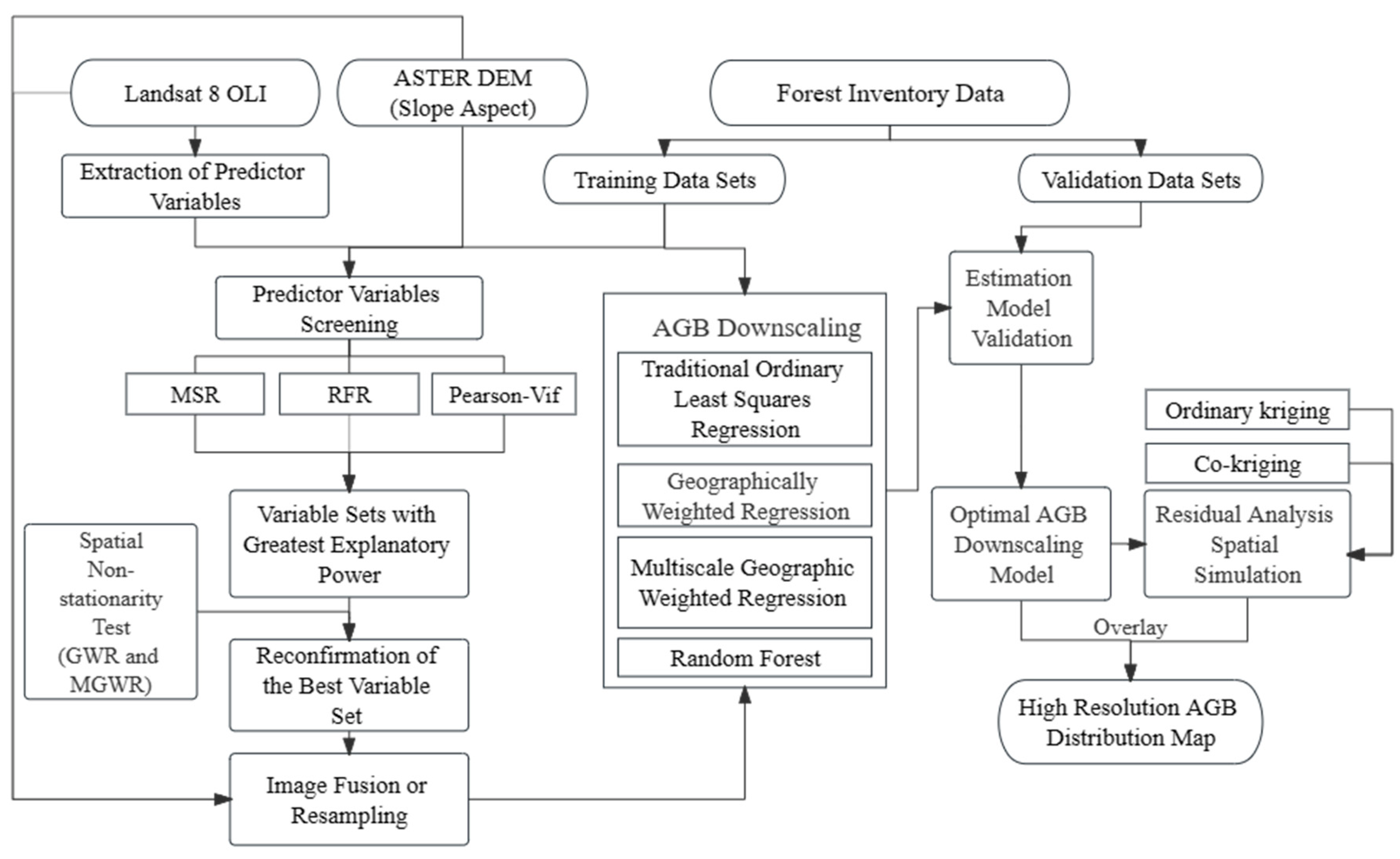
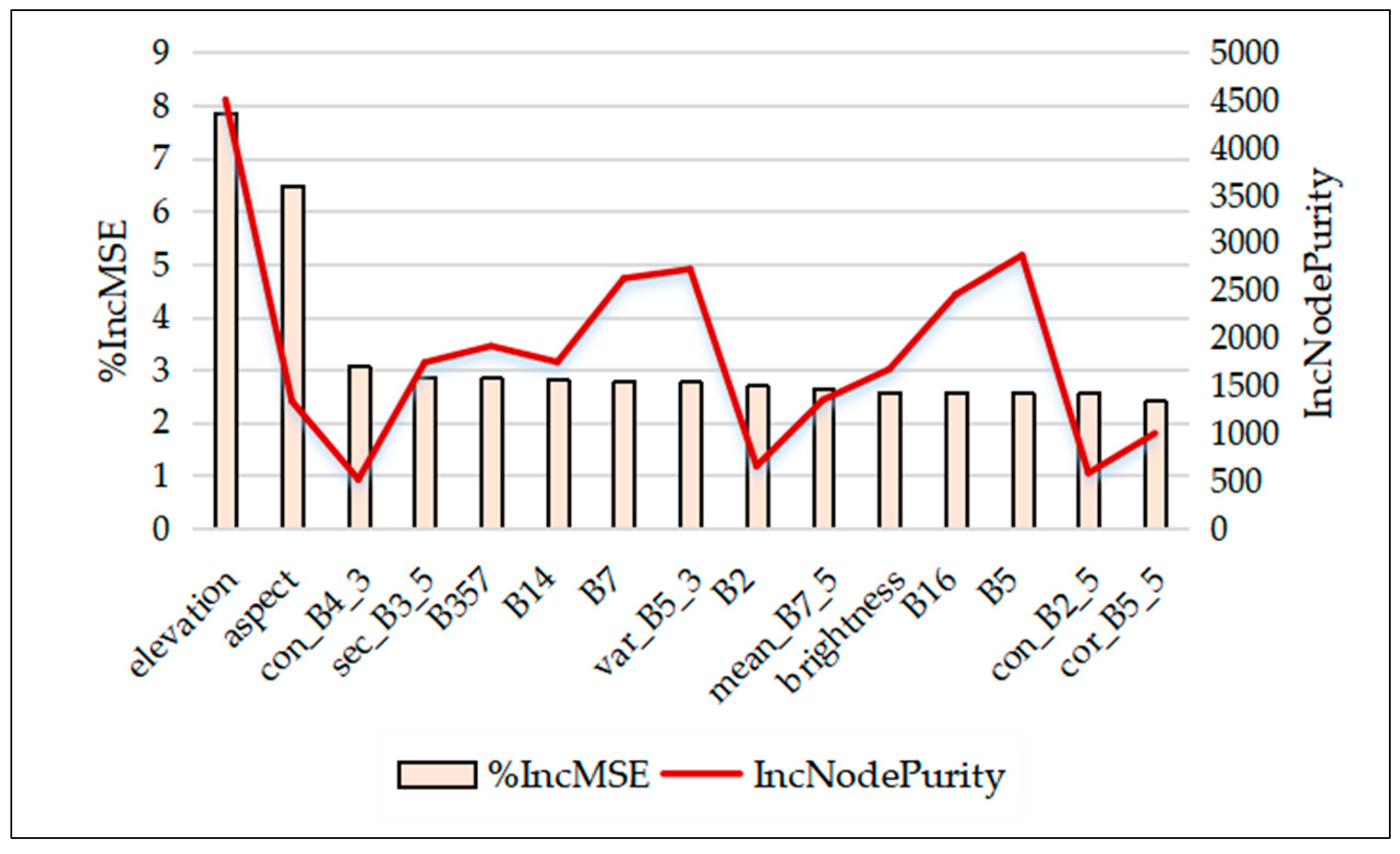
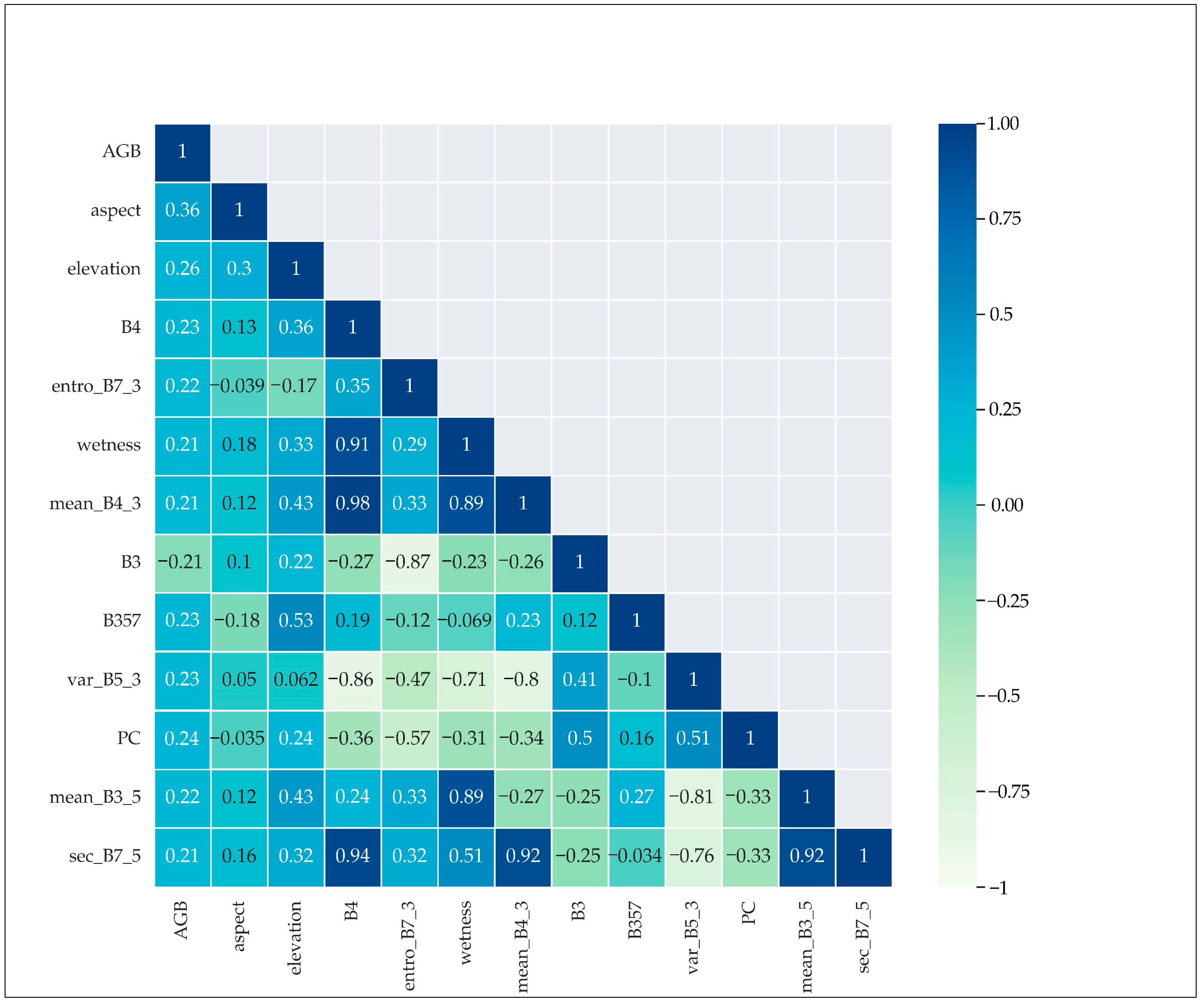

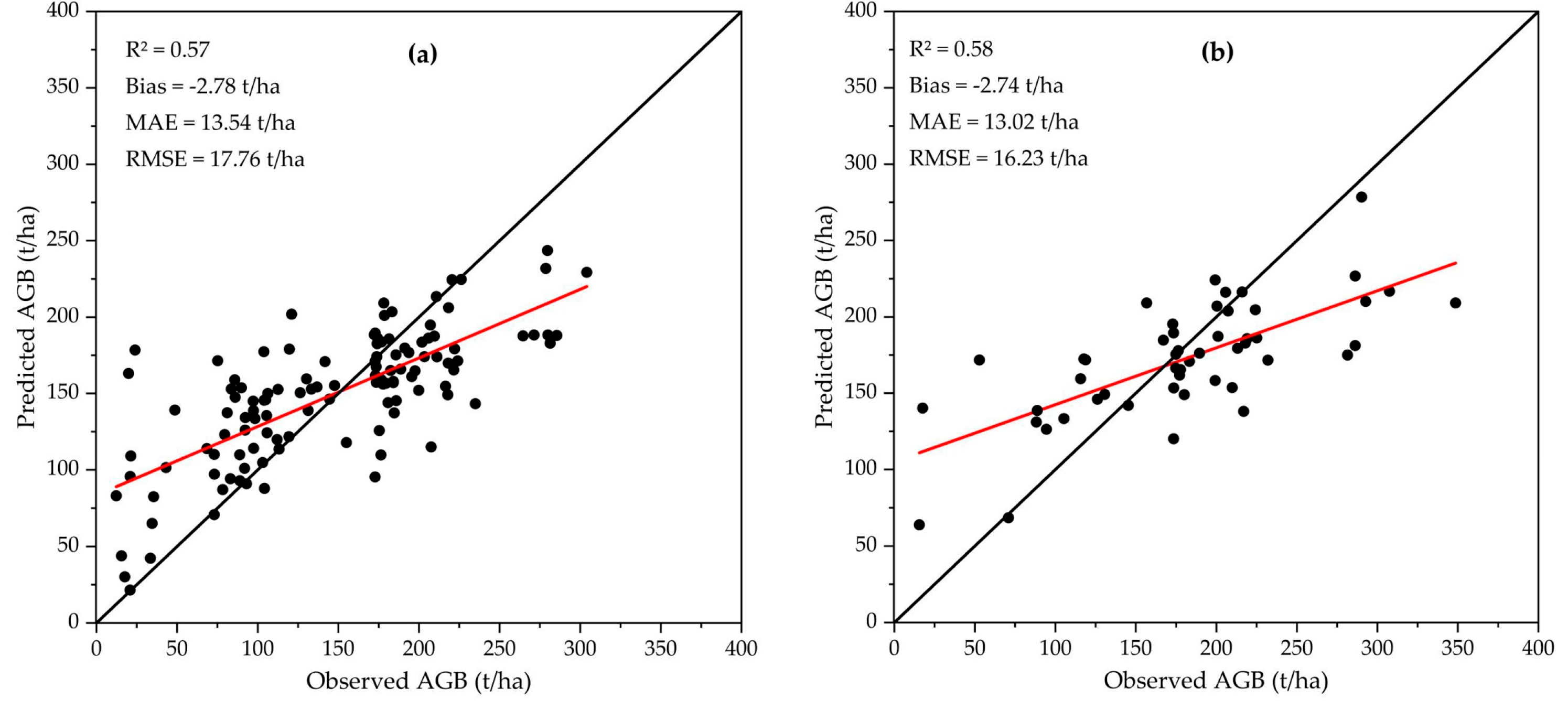
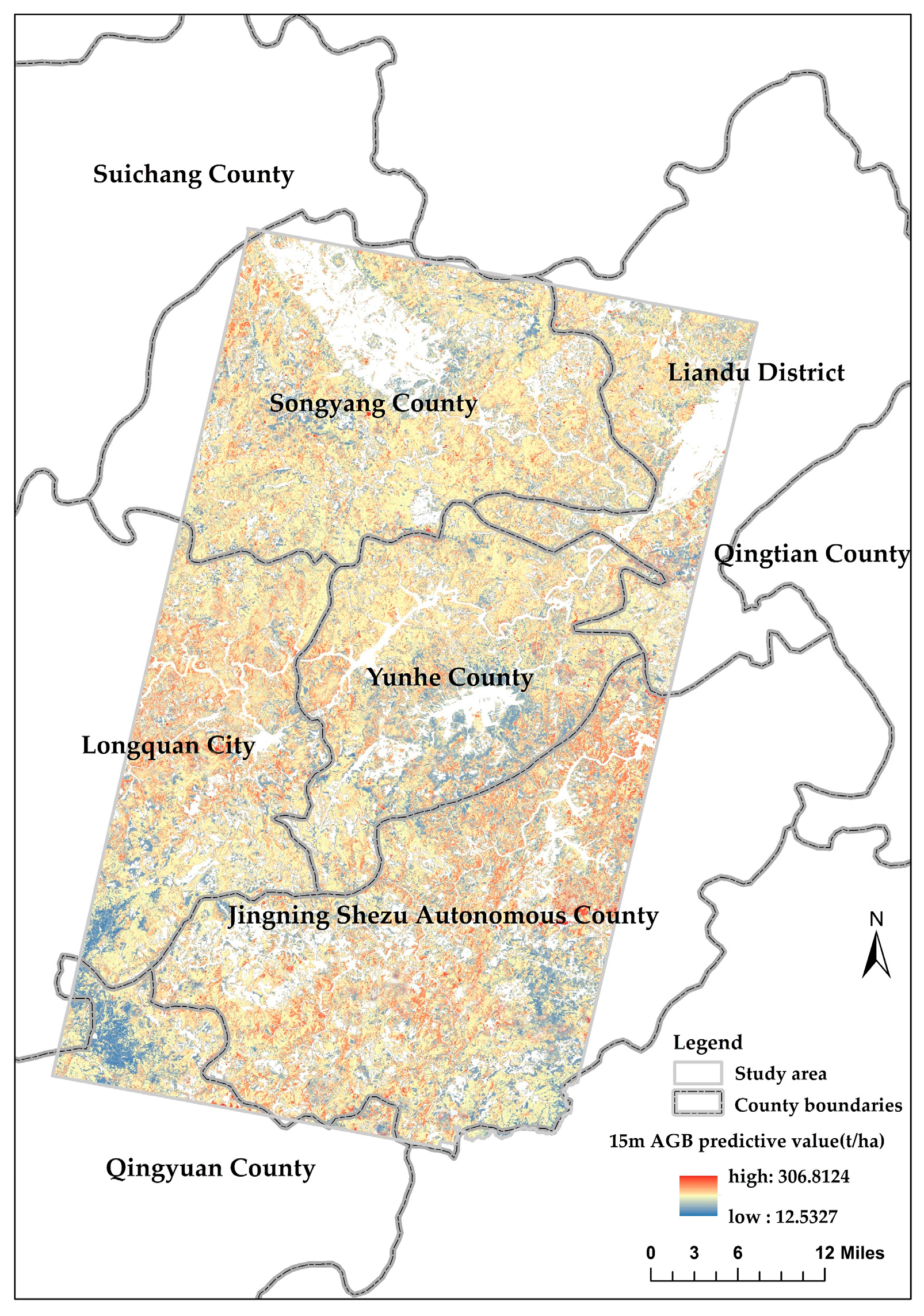
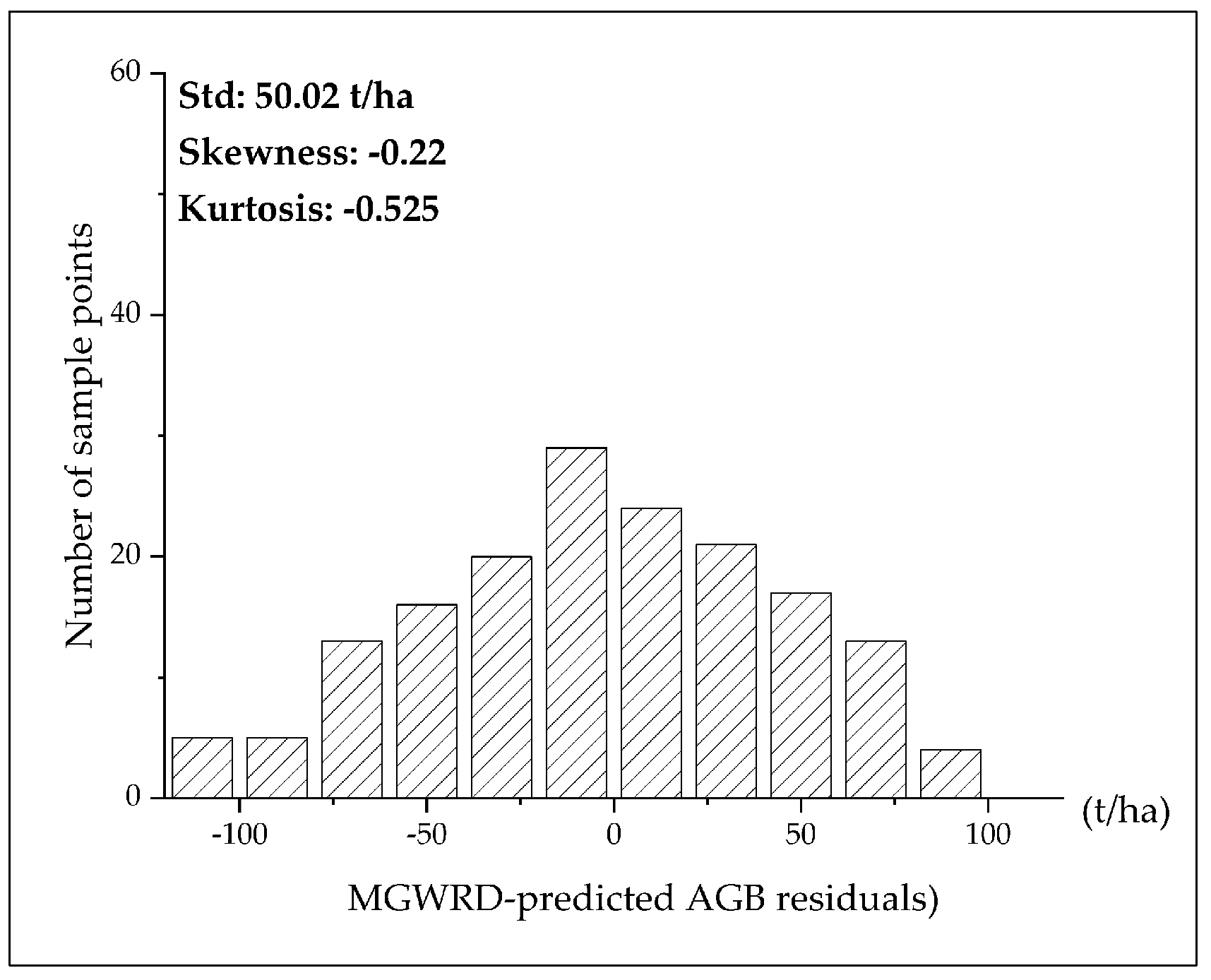
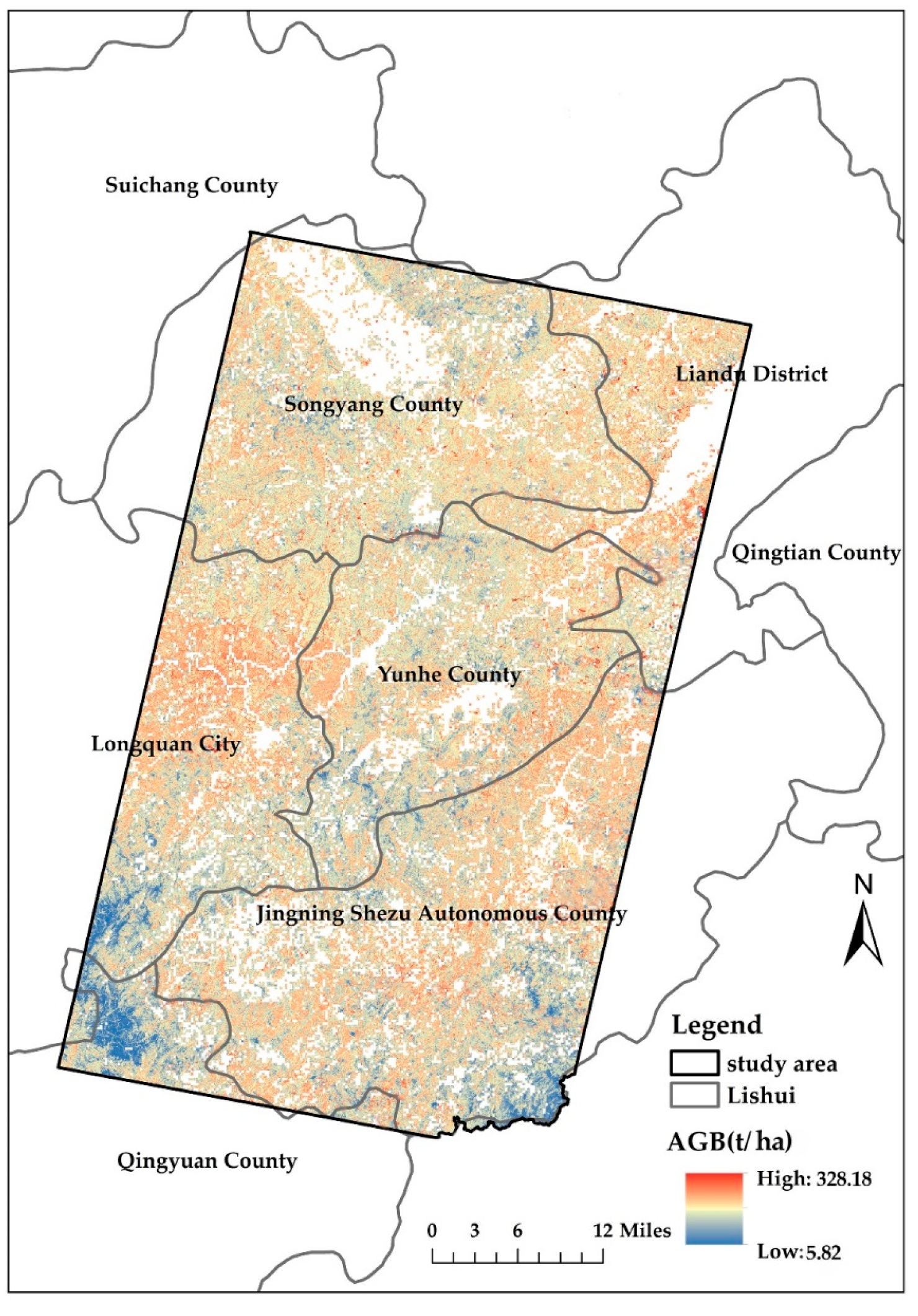
| Number of Sample Plots | AGB (t/ha) | Number of Samples Used | ||||
|---|---|---|---|---|---|---|
| Range | Median | Average | Std Deviation | Training | Validation | |
| 168 | 12.21–348.53 | 174.28 | 157.26 | 71.43 | 118 | 50 |
| Variable Selection Algorithm | Fitting Equation |
|---|---|
| MSR | Y = 18.3836 + 0.27699+ 1.7721 + 1.7811 + 1.9741 − 7.1878+ 7.6935 − 2.3673 + 3.7678 − 1.5526 + 1.2759 + 1.6467 + 0.8492 |
| Variable Screening Method | Evaluation Indicators | |||||
|---|---|---|---|---|---|---|
| Model | RSS | AIC | AICc | CV | R Square | |
| Random Forest Ranking | OLS | 1390.85 | 867.06 | 932.83 | 67.96 | 0.46 |
| GWR | 348.55 | 743.19 | 873.28 | 52.18 | 0.53 | |
| MGWR | 177.72 | 382.75 | 402.23 | 48.89 | 0.58 * | |
| RF | 567.34 | -- | -- | 59.87 | 0.52 | |
| Multiple Stepwise Regression | OLS | 1523.64 | 1070.95 | 1107.93 | 95.54 | 0.32 |
| GWR | 394.78 | 966.36 | 995.33 | 68.91 | 0.43 | |
| MGWR | 282.45 | 435.41 | 451.82 | 65.98 | 0.47 * | |
| RF | 591.21 | -- | -- | 74.64 | 0.44 | |
| Pearson-VIF | OLS | 1693.49 | 1146.13 | 1183.11 | 80.88 | 0.30 |
| GWR | 418.83 | 1166.42 | 1226.15 | 83.63 | 0.44 | |
| MGWR | 289.19 | 438.98 | 476.13 | 78.28 | 0.45 | |
| RF | 650.28 | -- | -- | 89.46 | 0.43 | |
| Kriging Method | Semi-Variogram Models | Nugget | Sill | Nugget/Sill | Range/m | R2 | RSS |
|---|---|---|---|---|---|---|---|
| OK | Exponential | 176.19 | 320.87 | 0.55 | 10293 | 0.78 | 8291 |
| Spherical | 182.23 | 289.74 | 0.61 | 8464 | 0.61 | 10922 | |
| Gaussian | 156.39 | 269.64 | 0.58 | 12732 | 0.74 | 9687 | |
| CK | Exponential | 153.24 | 289.13 | 0.53 | 11140 | 0.81 | 7963 |
| Spherical | 176.59 | 294.32 | 0.60 | 8833 | 0.63 | 10862 | |
| Gaussian | 162.32 | 275.12 | 0.59 | 12320 | 0.74 | 9375 |
| Model | MAE(t/ha) | RMSE/(t/ha) | R2 | Bias/(t/ha) |
|---|---|---|---|---|
| MGWRD | 13.02 | 16.23 | 0.58 | −2.74 |
| MGWRD-OK | 12.03 | 16.02 | 0.59 | −2.23 |
| MGWRD-CK | 10.62 | 15.38 | 0.62 | −1.69 |
Disclaimer/Publisher’s Note: The statements, opinions and data contained in all publications are solely those of the individual author(s) and contributor(s) and not of MDPI and/or the editor(s). MDPI and/or the editor(s) disclaim responsibility for any injury to people or property resulting from any ideas, methods, instructions or products referred to in the content. |
© 2023 by the authors. Licensee MDPI, Basel, Switzerland. This article is an open access article distributed under the terms and conditions of the Creative Commons Attribution (CC BY) license (https://creativecommons.org/licenses/by/4.0/).
Share and Cite
Wang, N.; Sun, M.; Ye, J.; Wang, J.; Liu, Q.; Li, M. Spatial Downscaling of Forest Above-Ground Biomass Distribution Patterns Based on Landsat 8 OLI Images and a Multiscale Geographically Weighted Regression Algorithm. Forests 2023, 14, 526. https://doi.org/10.3390/f14030526
Wang N, Sun M, Ye J, Wang J, Liu Q, Li M. Spatial Downscaling of Forest Above-Ground Biomass Distribution Patterns Based on Landsat 8 OLI Images and a Multiscale Geographically Weighted Regression Algorithm. Forests. 2023; 14(3):526. https://doi.org/10.3390/f14030526
Chicago/Turabian StyleWang, Nan, Min Sun, Junhong Ye, Jingyi Wang, Qinqin Liu, and Mingshi Li. 2023. "Spatial Downscaling of Forest Above-Ground Biomass Distribution Patterns Based on Landsat 8 OLI Images and a Multiscale Geographically Weighted Regression Algorithm" Forests 14, no. 3: 526. https://doi.org/10.3390/f14030526







